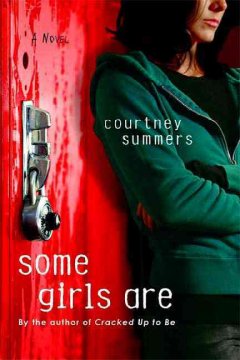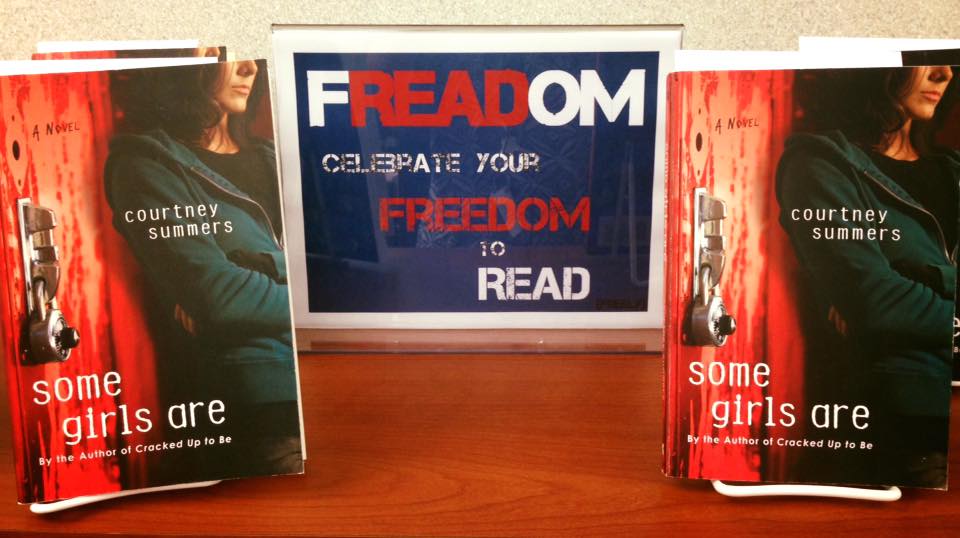In 2010, Courtney Summers published a book titled Some Girls Are. The novel tells the story of Regina, a member of her high school’s most elite and vicious peer group–until she reports a sexual assault involving her best friend’s boyfriend. Then Regina finds out what it’s like to be on the outside, on the receiving end of her clique’s cruelty, and ultimately finds her hope of redemption at the hands of one of her former victims. By no means is Summer’s book an ‘easy read’, but its frank and honest discussion of some very serious topics won it considerable acclaim, as well as the American Library Association (ALA)’s Young Adult Library Services Association Best Fiction for Young Adults in 2011.
 However, after the book was listed as an option for freshmen taking Honors English at West Ashley High School in Charleston, SC this past summer, a parent wrote a letter condemning not only the material in the book, but the teachers who assigned it, and the school that would sanction such teachers: “As a parent, I trusted that the educators, who have been chosen to mold our children, would have better judgment. My question is whether they even read this book before assigning it. If they did, shame on them. If they didn’t, shame on them.” *
However, after the book was listed as an option for freshmen taking Honors English at West Ashley High School in Charleston, SC this past summer, a parent wrote a letter condemning not only the material in the book, but the teachers who assigned it, and the school that would sanction such teachers: “As a parent, I trusted that the educators, who have been chosen to mold our children, would have better judgment. My question is whether they even read this book before assigning it. If they did, shame on them. If they didn’t, shame on them.” *
She then filed a formal request not only that her child be excused from reading the book, but also that access to Some Girls Are be restricted at West Valley High School to those students whose parents have given permission for their children to read, view, or listen to the work, and that the book be removed from the school’s library media center’s resource collection. In July, before the school committee could meet, the book was removed from the summer reading list.
In response to the incident, author Courtney Summers wrote a beautiful post on her website explaining her work, and providing a critical warning regarding banning books:
While it’s commendable that Melanie MacDonald is actively involved in her daughter’s reading life, it is not one parent’s place to make a judgment call and presume the experiences and reading needs of all teenagers.
What’s more, books provide us with the opportunity to empower teens by letting them have a say and a choice in what is relevant to their lives. This gives us the chance to talk with them about it and it is so important for teen readers to be heard and listened to.
Some Girls Are is a confrontational no-holds-barred look at young adolescent life. It’s about bullying–something most teenagers witness, experience or perpetuate in their school careers. It’s about a highly toxic culture that fosters aggression between girls. The novel explores the consequences of hurting people and asks us to consider the impact our actions have on others. It’s about picking up the pieces of our mistakes and bettering ourselves. It’s about forgiveness…We don’t protect teen readers by denying the realities many of them are faced with. Often, in doing so, we deny them a lifeline.
 And it is right about here that the story takes a turn for the inspirational. Kelly Jansen, an editor at the super-fantastic website Book Riot got wind of what was going on in South Carolina, and decided to take some action of her own. Jansen worked together with Andria Amaral, a super-fantastic librarian in the Charleston County Library system, and put out a call to put a copy of Some Girls Are in the hands of every reader who wanted one. “[Andria] said to me that she wants to stand at the door of the high school and pass this book out to kids,” Jensen wrote. “If you are willing to buy a copy of Summers’s Some Girls Are, I will send it down to Andria, who will get it into those kids hands for free.”
And it is right about here that the story takes a turn for the inspirational. Kelly Jansen, an editor at the super-fantastic website Book Riot got wind of what was going on in South Carolina, and decided to take some action of her own. Jansen worked together with Andria Amaral, a super-fantastic librarian in the Charleston County Library system, and put out a call to put a copy of Some Girls Are in the hands of every reader who wanted one. “[Andria] said to me that she wants to stand at the door of the high school and pass this book out to kids,” Jensen wrote. “If you are willing to buy a copy of Summers’s Some Girls Are, I will send it down to Andria, who will get it into those kids hands for free.”
The results were, quite literally, overwhelming. Early in September, Jansen reported that some 830 copies of Some Girls Are were posted to her house, and some $600 in funds were sent to help cover the cost of mailing those books to South Carolina (the money that didn’t go to shipping went to purchasing another 100 copies of the book). This is what the display looked like in Amaral’s library:

The library also hosted book discussion groups and programs so that teen readers had a safe space to talk about the book, as well.
Let’s be clear: This story would never have happened had not a handful of people felt justified in denying other people the right to think and read for themselves (as well as prove themselves unwilling to talk with their children about the book). In the end, students didn’t have the opportunity to discuss this book in school, which is where education should happen. However, the ending of this story is a marvelous one; the rights of readers and free thought were defended by a group of people who far outnumbered those who wished to take those rights away–people across the country, many of whom had never seen the teenaged readers of Charleston County, South Carolina. Perhaps most importantly, those teenagers had the opportunity to see, firsthand, that people cared about them, about their thoughts, their voices and their right to make decisions for themselves. And what a powerful lesson that is.
———
* I feel the need to assure everyone reading this that yes, teachers and librarians read every book we assign. We often read them many, many times.

